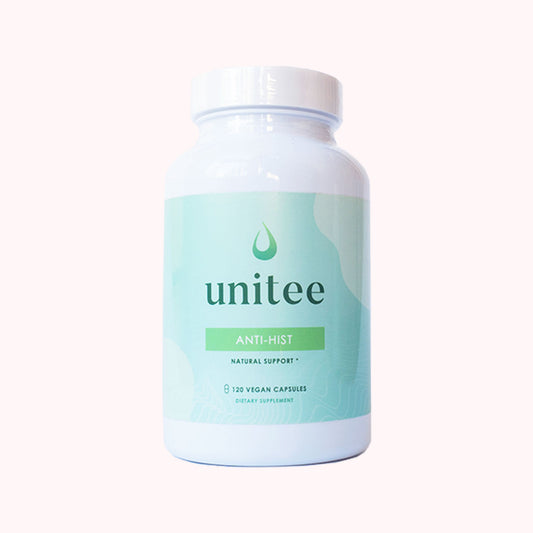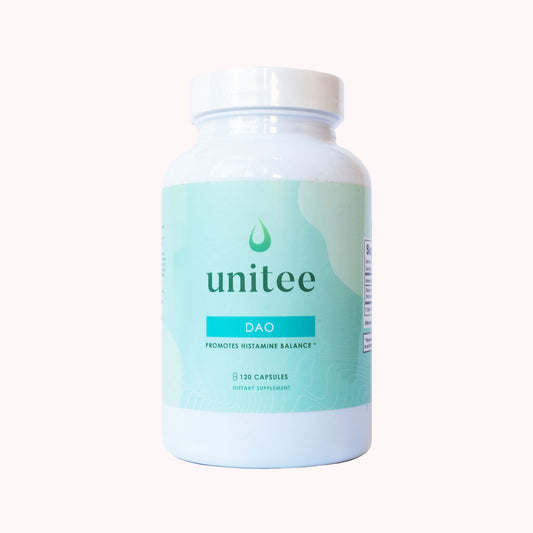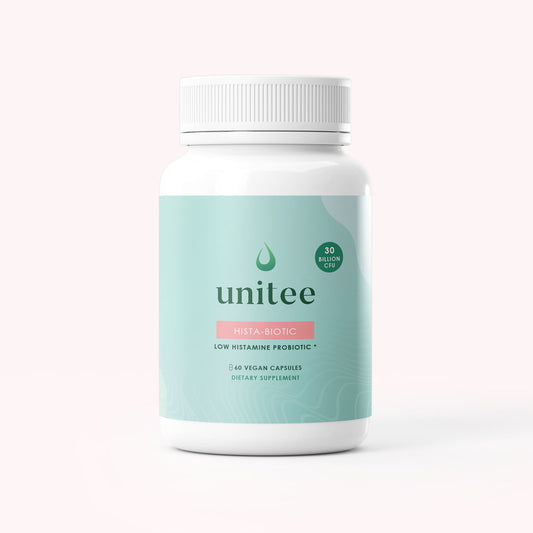Your hormones are there to tightly regulate many critical processes that take place in your body. When they’re doing their job, you have loads of energy, you’re fit and strong, you’re on the ball and you simply feel amazing every day.
But, as someone who has histamine intolerance, do you even remember what feeling this way is like anymore?
No?
Well, one of the reasons is because those essential hormones that are supposed to keep your body running like a well-oiled machine, have started to cause problems instead.
The hormone estrogen and its dysregulation is the one we’re going to focus on today.
The Histamine Estrogen Connection
Histamine intolerance (HIT), affects many more women (1) than it does men and it may be because estrogen is predominantly found in women. We say predominantly because men also require a certain level of estrogen to function.
For the sake of ease of understanding, this article will address what typically happens in the female body when it comes to the interplay between estrogen and histamine.
As a recap, estrogens are actually a group of hormones produced by the ovaries and they are important for sexual characteristics and reproductive development.
While estrogens are normally under tight regulation during a woman’s reproductive years, we are seeing more and more dysregulation of this group of hormones in younger women.
Often, this dysregulation is associated with higher than typical levels of estrogen, where there is too much of the hormone flowing through the body. Knowing that estrogen is associated with health in women, having more might seem like a good thing, but it’s really not. It’s maintaining estrogen levels within an optimal range that gives the most benefit, so having more can cause just as many problems as having less (2).
Symptoms of estrogen imbalance include:
- Irregular, heavy or painful periods
- Changes in bowel movements (diarrhea or constipation)
- Breast tenderness and other symptoms of PMS
- Acne
- Fatigue
- Irritability and anxiety
- Etc.
Estrogen production can be affected by a number of factors; some of them, most commonly being blamed as a result of our modern day lifestyle and habits, include:
- Stress
- Exposure to toxins, chemicals and heavy metals
- Exposure to exogenous estrogen sources and endocrine disrupting chemicals (EDCs)
- Use of oral birth control
- Chronic illness and inflammation
- Diet
But what does this have to do with HIT?
From the symptoms related to estrogen imbalance listed above, it’s easy to see they can be very similar to symptoms of histamine intolerance. That’s because of the close link between these two chemical messengers and how they affect one another.
Histamine Intolerance or Her-stamine Intolerance?
Estrogen production surges at specific intervals throughout the month. During the first part of the menstrual cycle, called the follicular phase, which takes place from the first day of bleeding until ovulation, there is a steady rise in estrogen. There's a quick peak of estrogen supply just before ovulation, which is followed by la steady decline in the levels of the hormone following ovulation. Another peak is seen during the luteal phase, which is the phase that takes place from the time of ovulation, until the first day of the menstrual bleed. This peak of estrogen happens a couple of days before the first day of menstruation, and quickly declines just before the first day of menses. This surges in estrogen followed by its decline, relies heavily on the body’s ability to clear estrogen. In other words, in order to maintain estrogen within optimal levels throughout the cycle, the body needs to be able to break it down and render it inactive, making it available to be eliminated by the bowels and through the urine (3).
Problems with the process of inactivating estrogen or issues relating to increased production or supply of active estrogen is where the trouble comes in.
If estrogen levels remain high, it continues to signal specific tissues to continue performing a function; but one that may no longer be required (3)!
While estrogen predominantly uses specific estrogen receptors to elicit action, one of the other signalling pathways that estrogen uses is via the H1 receptor (3).
Where do you know about the H1 receptor from? Histamine activation, of course!
Histamine and Its H1 Receptor Activation
Before we get into the estrogen-H1-histamine link, you may find yourself needing to brush up on the different histamine receptors and their associated functions. Check out my ultimate guide to histamine intolerance to get the scoop.
When histamine binds to the H1 receptors, what does it do? It causes an allergic-type response. What do you think happens when estrogen binds to H1 receptors? Exactly! The same thing.
Now, H1 receptors are readily spread throughout the women's reproductive system (4), found in high numbers in the uterus and ovaries where estrogen elicits its greatest response. The reason H1 receptors are rife in this part of the body is because histamine actually plays an important role in regulating ovulation, as does estrogen (5).
But that means, when estrogen is not cleared as it should be, more histamine reactions take place, and histamine-like symptoms increase (6), as do symptoms associated with estrogen dysregulation.
Mast cells also have sex hormone receptors, which means they can respond to signals directly from estrogen or progesterone. If you have higher than normal estrogen levels, mast cells are more readily activated. Because mast cells contain histamine, when they're activated, they degranulate, releasing their histamine (and other inflammatory cytokines), causing a rise in the body's levels of histamine (7,8). And you guessed it, more histamine-like symptoms to develop.
If you thought that was enough, you also have the indirect effects that histamines have on estrogen that take place at the same time.
As more histamine is released into your system, estrogen production is stimulated, and vice versa, which kicks off a vicious cycle of dysregulation of both chemical messengers (9).
For this reason, many women experience a worsening of their symptoms around the time of ovulation and then again just before menstruation begins (10). If you remember from above, it's the times in the cycle that the surges of estrogen take place.
Still, there's more!
Estrogen Also Affects the DAO Enzyme
There’s also the question as to how estrogen affects the DAO enzyme. If you remember from my previous articles, it's one of the essential enzymes required to break down histamine. This link becomes more clear when we look at what happens during pregnancy.
Have you ever heard that pregnant women have almost spontaneous resolution of immune disorder symptoms?
It’s by no means a miracle, even if the baby is! This resolution of immune disorders has to do with the alterations in hormone production that is necessary to maintain pregnancy. More importantly, it has to do with the surge in the production of the DAO enzyme by the placenta (11). The reason that the placenta begins to produce high amounts of DAO is actually quite fascinating.
As you now know, histamine has a stimulatory effect on the ovaries and uterus, but it also impacts the developing embryo. Because of this, the placenta acts as a DAO-containing barrier or shield to prevent the effects that histamine may have on the maintenance of pregnancy and fetal growth and development (11). Not only can higher than normal histamine levels interfere with implantation of an embryo, it could also increase the risk of miscarriage, preterm labor and cause complications in pregnancy such as preeclampsia and hyperemesis gravidarum (serious nausea and vomiting).
DAO, therefore, helps to decrease histamine for a healthy pregnancy and significantly decreases the histamine load in the body, which is why allergic-like and immune related symptoms decrease in pregnant women (12). While not the main topic of discussion in this article, histamine intolerance may still bother pregnant women despite this protective mechanism, and it may be worth following a low histamine diet while trying to conceive if you're experiencing histamine-like symptoms and/or you're having difficulty trying to conceive.
While it’s clear that estrogen has a role in histamine load and vice versa, the question still remains: what can you do about it?
Balancing Hormones to Tackle Histamine Intolerance
One change you can begin to make right now in how your body reacts to histamine is to look at your diet. To give your body a break, it's important to cut out as many histamine increasing or DAO-blocking foods as you can. You can access a comprehensive list of both high and low histamine foods here. Additionally, adding a DAO supplement can be of great assistance with stabilizing DAO levels in order to appropriately break down histamine.
At the same time, you can begin your investigation into the role estrogen plays in your histamine intolerance. It’s worthwhile speaking to your doctor to obtain tests to determine your hormone levels, which includes estrogen, progesterone and testosterone.
Be sure to take note of where you are in your menstrual cycle when you get your results, as this can give you a fair amount of information as to whether your hormone levels are appropriate for that time of the month or not.
If you’re highly stressed, are taking hormone therapy or have any other reason to suspect that your estrogen levels may be linked to your histamine intolerance, a full hormone test (such as the DUTCH test) can help you to pinpoint where the irregularities may lie.
Two other factors to consider when it comes to managing estrogen levels are:
-
Your liver function.
Your liver makes and secretes bile into the gallbladder, which is needed to bind estrogen during the process of elimination. If the liver is not producing enough bile, estrogen can be reabsorbed into your system and continue to produce effects (13).
Additionally, if the liver is underperforming for any reason, it may be sluggish in breaking down estrogen in the first place, allowing higher levels to be recycled in the body.
-
Fiber content in the diet
When fiber intake is insufficient, there may be impaired elimination of the products of estrogen through bowel movements. Infrequent bowel action may not only indicate lower levels of fibre in the diet, but also why there may be an increase in estrogen activity.
Working with a qualified healthcare professional who specializes in hormone activity is highly recommended, as is the right approach to testing your hormone levels.
References
- Jarisch R. (2015) Histamine Intolerance in Women. In: Jarisch R. (eds) Histamine Intolerance. Springer, Berlin, Heidelberg.
- Patel S, Homaei A, Raju AB, Meher BR. Estrogen: The necessary evil for human health, and ways to tame it. Biomedicine & Pharmacotherapy. 2018;102:403-411. doi:10.1016/j.biopha.2018.03.078
- Bodis J., et al. The effect of histamine on progesterone and estradiol secretion of human granulosa cells in serum-free culture. Gynecol Endocrinol 1993;7:235–9.
- Mori H, Matsuda K, Yamawaki M, Kawata M. Estrogenic regulation of histamine receptor subtype H1 expression in the ventromedial nucleus of the hypothalamus in female rats. PLoS One. 2014;9(5):e96232. Published 2014 May 7. doi:10.1371/journal.pone.0096232
- Szelag A, Merwid-Lad A, Trocha M. Receptory histaminowe w zeńskim narzadzie rodnym. Cześć I Rola komórek tucznych i histaminy w zenskim narzadzie rodnym [Histamine receptors in the female reproductive system. Part I. Role of the mast cells and histamine in female reproductive system]. Ginekol Pol. 2002;73(7):627-635.
- Kalogeromitros D., et al. Influence of the menstrual cycle on skin-prick test reactions to histamine, morphine and allergen. Clin Exp Allergy. 1995;25:461–6.
- Zierau, O., et al. Role of female sex hormones, estradiol and progesterone, in mast cell behavior. Front Immunol. 2012; 3: 169.
- Zu, T., et al. Estrogen is an important mediator of mast cell activation in ovarian endometriomas. Reproduction. 2018. 155(1):73-83.
- Maintz, L., & Novak, N. Histamine and histamine intolerance. The American Journal of Clinical Nutrition. 2007. 85(5):1185-1196.
- Hamada, Y., et al. Effect of the menstrual cycle on serum diamine oxidase levels in healthy women. Clinical biochemistry. 2013. 46.1-2: 99-102.
- Maintz, L., et al. Effects of histamine and diamine oxidase activities on pregnancy: a critical review. Hum Reprod Update. 2008 Sep-Oct;14(5):485-95.
- Morel F, Surla A, Vignais PV. Purification of human placenta diamine oxidase. Biochem Biophys Res Commun 1992;187:178–86.
- Tsuchiya Y, Nakajima M, Yokoi T. Cytochrome P450-mediated metabolism of estrogens and its regulation in human. Cancer Lett. 2005;227(2):115-124. doi:10.1016/j.canlet.2004.10.007
- Zengul AG, Demark-Wahnefried W, Barnes S, et al. Associations between Dietary Fiber, the Fecal Microbiota and Estrogen Metabolism in Postmenopausal Women with Breast Cancer. Nutr Cancer. 2021;73(7):1108-1117. doi:10.1080/01635581.2020.1784444

Anita Tee
My name is Anita Tee. I'm a nutritional scientist who specializes in histamine intolerance. I hold a Master of Science in Personalized Nutrition and a Bachelor of Science in Human Biology and Psychology.
For the past ten years, I have used my experience in nutritional and medical health sciences to create a scientifically backed, natural approach to healthcare that relies 100% on evidence-based research.
As I previously suffered from - and overcame - histamine intolerance, my focus is to increase recognition and expand the available resources and protocols available for resolving this particular disorder. To date, I have helped over 4,000 individuals fully resolve or better manage their histamine intolerance symptoms.







